chromium
Hazard to Others
  
Posts: 284
Registered: 27-6-2005
Member Is Offline
Mood: reactive
|
|
Extract of Benzene thread
This is extract of Benzene thread http://www.sciencemadness.org/talk/viewthread.php?tid=325
As i want make benzene myself i started to read it and made notes for my own use. I soon realised that there is not much additional work if i try to
make it bit more systematically so that it can be used by others as well.
My work here is not perfect. But it does not pretend to be! I am too lazi :-). Hope you enjoi. If there are errors or anything that needs correcting
(including my english) then please comment or U2U.
Sumary
Benzene has many interesting and useful properties and is not always readily available. It is of great interest to make it from available chemicals.
Various methods of making benzene were proposed by members. Dry distillation of sodium benzoate with hydroxides appeared most promising after some
discussion. This idea was tested by several members. Decent amounts of benzene were obtained using self made distillation setups.
Making benzene
Lot of reactions that ought to give benzene as product were mentioned by mebers. It was proposed that benzene can be made...
1. by decarboxylation of benzoates or benzoic acid by heating per se or with hydroxides
2. by Friedel-Crafts reaction: AlCl3 will catalyze the conversion of toluene into benzene and mesitylene.
3. by reacting 1,3,5- trichlorocyclohexane with a strong base
4. by aldol condensation - involving adding a strong base to acetaldehyde
5. by dry distillation of phthalic acid with hydroxides
6. from acetone via trimethylbenzene.
7. by catalytic condensation of acetylene.
8. there was idea to put Al foil into toluene and let chlorine or hydrochloric acid gas to pass this mixture. Suposedly this should give benzene as Al
catalyser is made in situ.
9. from Chloramin-B by heating per se or with phosphoric acid to about 225°C. There was also warning that Chloramin-B could decompose explosively at
185C.
10. by tripopelpamziene decomposition
11. by condensation of methane with AlCl3 catalyst and heating
12. from benzene diazonium sulfate
13. by heating p-xylene with AlCl3 or other Friedel-Crafts catalysts
14. by organometallic methods by electrolysis with LiCl p-DCB in acetone or pyridine environment
15. by disproportionation of toluene or xylene using the Radzivanovskii in-situ AlCl3 catalyst
16. by distillation of phenol and Zn-powder
17. by passing vapours of Phenol over red-hot zinc dust.
18. by the Kolbe electrolysis, in which an alkali metal carboxylate is electrolysed
19. by the Hunsdiecker reaction
20. by decarboxylation of various substances in DMSO environment at <100C.
Most of these methods were not tested or discussed. There was some discussion on converting toluene with AlCl3 catalyst to benzene. Was proposed that
this catalyst can be made in situ conducting chlorine through toluene which contains some Al foil. Other member claimed that this would just
chlorinate toluene and gaseous HCl instead of chlorine should be used. This was not tested by members as handy ways to benzene were soon found.
First succesfull atempts
First successfull atempt was by user called IPN who conducted dry distillation of sodium benzoate mixed with sodium hydroxide. From 50g NaC6H5COO and
14g NaOH 24ml of crude distillate was obtained. This was orange liquid with sharp smell boiling at 82C. There was at least on serious problem: the
bottom of 250ml rb flask was severely dissolved, probably because of the NaOH.
Crude product was distilled again and 22.6ml water clear liquid with boiling point of 81C and with flavour like that of benzene was obtained. It was
observed that temeprature controll is of remarkable importance. If heated too strongly there appeared lot of orange oil-like substance that discolored
crude product. Slow heating was claimed to be good for abtaining less contaminated product and better yield.
This experiment was repeated with other members. Ordenblitz used 7g of NaOH and 25g NaC6H5COO that were roughly crushed together in a mortar and
pestle. The mix placed in a 500 ml rb flask, equipped with a condenser. Heat was applied by heating mantle in a slow manner for 30 minutes before a
slightly orange/yellow low viscosity condensate began to collect. The process continued for 35 more minutes until no more was collected.
The product was then redistilled rather quickly, easilly separating the orange solid from the desired material.
The final result was roughly 8 ml of, by all apperances, is a fairly pure product. No visable damage to the flask was noted even though the reactants
were not milled to a fine state as was suggested.
ordenblitz repeated this experiment with various hydroxides and got following yields:
7 gm. CaOH + 25 gm. C7H5NaO2 = 6ml C6H6
7 gm. KOH + 25 gm. C7H5NaO2 = 6.8ml C6H6
7 gm. NaOH + 25 gm. C7H5NaO2 = 7ml C6H6
He also tested product with FTIR and it appeared very good.
Instructions found by S.C. Wack
82. Preparation of a Hydrocarbon by Distillation of
a Salt of an Acid with Soda-Lime.-Benzene, C6H6.
(Phen.)
Literature.--Mitscherlich : Ann. Chem. (Liebig), 9, 39 : Mar-
ignac: Ibid, 42, 217; Wohler: Ibid, 51, 146; Berthelot: Ann.
Chim. Phys. [4], 9, 469; Hofmann ; Ber. d. chem. Ges., 4, 163;
Baeyer : Ibid, 12, 1311 ; V. Meyer : Ibid, 16, 1465.
20 grams benzoic acid.
40 grams soda-lime.
Mix 20 grams of benzoic acid with 40 grams of soda
lime by grinding together in a mortar. Put the mixture
in a small flask, connect with a condenser, and distil
over the free flame. Separate the benzene from the
water, dry it with calcium chloride, and distil. If per-
fectly dry benzene is desired, distil it a second time over
metallic sodium. Yield 8 to 9 grams.
Benzene solidifies at a low temperature, and melts at
5.42°: It boils at 80.36 ° .
This method of preparation is no longer practically
used, but it was of very great importance in the early
study of the aromatic hydrocarbons, and illutstrates a
method very general in its application.
From Norris' Experimental Organic Chemistry:
169. Preparation of Benzene from Benzoic Acid (Section 440).
--In a 6-inch evaporating dish place 10 grams of sodium
hydroxide and 25 cc. of water. Heat over a free flame and stir
until the sodium hydroxide dissolves; then stir in gradually
12 grams of benzoic acid. Evaporate to dryness over a free flame,
which is kept constantly in motion; this will take about 10
minutes. Grind the mixture of sodium benzoate and sodium
hydroxide in a mortar, and transfer it to an 8-inch test-tube.
Clamp the test-tube in an inclined position so that the mouth
of the tube is slightly lower than the other end; this will prevent
any water given off during the heating from running back into
the tube and cracking it. Connect the tube with a condenser
and receiver, and heat with a free flame kept constantly moving,
until no more liquid distils over. Measure the volume of the
benzene and calculate the number of grams and the percentage
yield obtained. Separate the benzene from the water, dry it
with calcium chloride, and distil, noting the temperature.
Benzene melts at. 5.5 °, boils at 79.6 °, and has the density
0.878 20C/4C. The yield should be about 6 grams.
NOTE.--By converting the benzoic acid into sodium benzoate in the pres-
ence of an excess of sodium hydroxide, an intimate mixture of the two sub-
stances is obtained. In this condition the compounds enter into reaction
more readily and at a lower temperature than does a mixture of the acid
and soda-lime; such mixtures are commonly used in the preparation of
hydrocarbons from acids.
The benzene prepared in this way contains a small amount of biphenyl,
which may be isolated from the residue left after the distillation of the hydro-
carbon. The residue on crystallization from alcohol yields crystals
of biphenyl, which after two sublimations melt at 71C.
Organicum experiments
Organicum repeated experiment that IPN and Ordenblitz did before. He used 100g benzoate and 60g NaOH in 500ml RB flask. It appeared that upscaling can
not be so easily done here. "It was found that the lower part of the mixture has molten but the upper part formed a kind of cover not falling
down to the bottom. Some agitation with a strong wire brought this down, some more benzene came over, but the amount is to small to be called a
satisfying result. The first fluffy then sticky consistence of the benzoate/hydroxide mixture seems to cause problems."
Main problems were clinging of the fused mass to the glass threatening to destroy it. Another problem was that not all benzoate reacted. "The
fused mass is an nice insulator and makes it hard if not impossible to get all to react after a certain amount has fused."
He made another experiment using 1000ml Erlenmayer flask with 100g sodium benzoate and 60g NaOH and 50g table salt as filler. "Hydroxide and some
salt where grinded together in the coffee mill and admixed with the benzoate by the ol´ "inflated plasticbag" (tm) method, whereby some
ungrinded salt was added into the Erlenmeyer, put in a sandbath isolated with glasswool and heated up."
This experiment appeared to be succesfull. Clear distillate came over at about 85°C (the temperature of the vapors measured in Claisen adapter) This
process appeared destructive to glassware. Every experiment ended with flask cracking because "fused mass clings so badly to the glass that the
different thermal expansion breaks it whilst cooling down."
Various ways were proposed to solve cracking glassware problem.
1. To use nickel or silver plating on inner surface of flask
2. to place gold or silver foil into the flask so that reaction mixture can not contact glass surface.
3. to use common glass bottles as cheap disposable flasks
4. To use metal vessels.
Steelwool as filler was proposed by Organicum to solve heat transfer problems. Use of metal rods or short tubes was also propsed.
Organicum started to use metal can as heating flask. Metal can was connected to the glass condenser by copper tubing. 1" thread of this tubing
was screwd to metal can and other end was used as socket for 29mm ground glass joint. Connection was thightened with teflon tape.
http://www.sciencemadness.org/scipics/benzoate_ver2.jpg
This metal can setup was used for several runs and always gave at least 120ml benzene from 300g sodium benzoate (molar yield of 68%). NaOH and sodium
benzoate were grinded and well mixed, steelwool was used to improve thermal conductivity. Old solvent cans were used. One can lasted for about three
to four runs and was then replaced. Organicum also tryed to replace NaOH with Ca(OH)2: "A run with calcium hydroxide instead of grinded sodium
hydroxide gave less product which was much more decolorized, thats a pity as Ca(OH)2 comes already as a fine powder and would make the grinding
unnecessary. So I stay with my (new-old) coffeegrinder and NaOH.... "
He also noted that crude distillate must be washed with water: "When the product of the sodium-benzoate destructive distillation is NOT washed
with water before distillation a clear distillate with a sharp pungent smell comes over at about 70°C. This is obviously an azeotrope of benzene with
an unknown compound."
Afterwards Organicum improved his setup by making it all metal. Condenser of new setup was essentially a copper tube cooled by tapwater falling onto
its external surface.
On bigger scale
Ordenblitz did similar synth on even bigger scale. Hi constructed distillation setup with metal can and water jacketed copper condenser. Similar to
that of Organicum but bigger and more elaborate.
http://img178.imageshack.us/img178/3643/cansetup2jq.jpg
"In the can was put 4 or 5 shredded stainless steel scrubber pads, for a conduction aid and a specially wet granulated, densified and beaded mix
of 2500 gm sodium benzoate + 1250 gm calcium hydroxide. I prefer to use Ca(OH)2 since I have to use less personal protection when mixing and
granulating. Clean up is easier and of course the stuff is cheaper."
Very strong heating was needed. First 3 hours on gas burner yielded only 250ml of distillate. After another hour or two things started to slow down.
"650 stinking milliliters for all that hard work and waiting, pathetic! I expected about 1500ml. After opening the can I noticed that most of the
center of the mass was un-reacted and the top looked all but untouched. I had the lower 1/3 of the can cherry red after the 3rd hour.
My conclusion is that scaling this reaction up without a lot of fairly technical hardware, is probably just not worth the effort. "
"Taking a second look at the monster distillation can for benzene, I decided to scale the quantity back and shorten the time. I put 1100g of my
2/1 sodium benzoate/calcium hydroxide mix (about 30% of the original load) into the can. This filled it roughly 1.3 inches. I wanted a thin layer this
time. I then connected the condenser and fired up the burner. In 30 minutes the distillate stopped coming over and I had 210ml of product.
http://img217.imageshack.us/img217/7693/2107ud.jpg
Not bad for 40 minutes of work. Next I decided to try sodalime to see if the lower melting point would hasten the reaction or increase the yield. So
to 1100g of the mix I added 200ml 40% NaOH solution, mixed thoroughly and added to my can. I turned on the flames and in less then 20 minutes it was
all over. This time I had 200ml of liquid goodies. So, faster yes but slightly poorer yield.
While the can is still hot I open it up and hit it with the hose and the thermal shock breaks the clinker into a thousand pieces and I simply dump out
the chunks, load her up and off we go again. A day of this and quite a bit of benzene could be had."
I have run this now about 4 times and I think the can should last quite a while. The only thing I need to replace is the cap seals, which I cut out of
high temp silicone.
It is interesting to note that the faster you push this reaction the redder the product gets. Compared to my first batch it looks a deep red. The only
difference between the first run and the second was load in the can and how fast I heated it up. The final test will be when it's distilled and
the tally taken. I assume that I made a bit more biphenyl by pressing it hard. I will sort out the final count and post."
"All the batches are now finished and from 2500gm/1250gm, sodium benzoate/calcium hydroxide and some time I have about 1.4 liters of benzene. Not
too bad at all. I managed to save the unreacted material from my first run and add it to subsequent runs. As long as I keep the load in the can at
about 1000 grams, I get very good yields.
I distilled the darker batches and the lighter yellow ones separately. While the distillate from the faster hotter runs is more toward the red/orange,
it results in less solid matter (biphenyl etc) remaining after the finish distillation. So I say, hotter and faster is better.
I got a picture of the clinker that I broke out of the can. It is very light and porous looking a lot like lava rock or pumice. One other interesting
thing is that it is very hard after coming out of the can but upon exposure to the air for a day it completely disintegrates into dust. So to make
cleanup easy after a run, just let your vessel sit open for a while and dump out the powder."
About starting materials
There was not much discussion on starting materials as alkali benzoates are easily available. Benzoates are used as food additives, antiseptics and
antioxidants. There were short referneces to process of oxydation of toluene by potassium permanganate to get potassium benzoate.
|
|
|
Polverone
Now celebrating 21 years of madness
        
Posts: 3186
Registered: 19-5-2002
Location: The Sunny Pacific Northwest
Member Is Offline
Mood: Waiting for spring
|
|
PDF made. But there are some puzzling bits to fix:
What is the "tripopelpamziene" that Organikum suggested decomposing to form benzene?
In Norris' Experimental Chemistry, what was the passage "has the density 0.878 20C/4C." intended to be? I could expect two specific gravities at two
temperatures, but it looks here like one specific gravity and two temperatures.
I couldn't load the image http://img178.imageshack.us/img178/3643/cansetup2jq.jpg, which was a picture of Ordenblitz's benzene distillation setup. I'd appreciate it if
Ordenblitz or anyone else who might have saved the picture could upload it so it can be added to the document.
Here is a preliminary version of the document:
http://www.sciencemadness.org/scipics/benzene_production.pdf. I would appreciate help with the above-noted problems as well as any other
corrections, additions, or observations.
PGP Key and corresponding e-mail address
|
|
|
Darkblade48
Hazard to Others
  
Posts: 411
Registered: 27-3-2005
Location: Canada
Member Is Offline
Mood: No Mood
|
|
| Quote: | Originally posted by Polverone
I couldn't load the image http://img178.imageshack.us/img178/3643/cansetup2jq.jpg, which was a picture of Ordenblitz's benzene distillation setup. I'd appreciate it if
Ordenblitz or anyone else who might have saved the picture could upload it so it can be added to the document.
|
I'm not quite sure what the problem was, the link worked fine for me, here's another attempt:
<a href="http://img202.imageshack.us/my.php?image=cansetup2jq2vs.jpg" target="_blank"><img
src="http://img202.imageshack.us/img202/3561/cansetup2jq2vs.th.jpg" border="0" alt="Free Image Hosting at www.ImageShack.us" /></a>
|
|
|
Polverone
Now celebrating 21 years of madness
        
Posts: 3186
Registered: 19-5-2002
Location: The Sunny Pacific Northwest
Member Is Offline
Mood: Waiting for spring
|
|
Strange, it was timing out for me before. Thanks. PDF has been updated.
PGP Key and corresponding e-mail address
|
|
|
S.C. Wack
bibliomaster
    
Posts: 2419
Registered: 7-5-2004
Location: Cornworld, Central USA
Member Is Offline
Mood: Enhanced
|
|
| Quote: | Originally posted by Polverone
density 0.878 20C/4C |
As printed, it was fractionish. It was a 20° above a 4°, separated by a -. Most everywhere else uses notation like the Merck Index, with the d
followed with the 20 above the 4 with no degree sign or -. The 4° referring to the highest density of water for comparison, 1000g/L. Why there is
25/25 or 25/20, etc., I've no idea.
|
|
|
crazyboy
Hazard to Others
  
Posts: 436
Registered: 31-1-2008
Member Is Offline
Mood: Marginally insane
|
|
I know this thread is kind of old but I have a question. I plan on doing a small scale benzene extraction but I don't really want to use my Coleman
stove. Would a lab hotplate get hot enough to distill all the benzene off?
|
|
|
Magpie
lab constructor
    
Posts: 5939
Registered: 1-11-2003
Location: USA
Member Is Offline
Mood: Chemistry: the subtle science.
|
|
So you want to know if it would get hot enough to distill off the benzene? The bp of benzene is only 80C. That's less than the bp of water.
Your Coleman stove will boil water won't it?
But please do not just evaporate the benzene off over an open flame. Benzene is very flammable and you could be badly burned and/or set the place on
fire.
[Edited on 23-3-2008 by Magpie]
|
|
|
crazyboy
Hazard to Others
  
Posts: 436
Registered: 31-1-2008
Member Is Offline
Mood: Marginally insane
|
|
Yeah I know the boiling point of benzene is low and I won't use an open flame but for some reason I thought that the reaction had to take place at a
higher temp (like the melting point of NaOH) re-reading the thread reveals the distillate coming over at 81C which is reassuring. Thanks.
|
|
|
Magpie
lab constructor
    
Posts: 5939
Registered: 1-11-2003
Location: USA
Member Is Offline
Mood: Chemistry: the subtle science.
|
|
Well, I wasn't clear what you were trying to do when you said "distill an extract." If you meant that you intend to synthesize benzene by
decarboxylation of benzoic acid (or sodium benzoate) with NaOH (or such) then that is a different matter. In that case everything is enclosed in the
reaction vessel and condenser/receiver so the risk of fire is pretty low. In fact my college lab procedure manual says to do this with a bunsen
burner, obviously an open flame.
In my experience with doing this I had to play the flame over a large test tube containing the solid mix of sodium benzoate/NaOH. So it is a bit hard
to see how this could be done using a Coleman stove. The problem is one of heat transfer to the solids, i.e., they conduct heat very poorly.
|
|
|
Axt
National Hazard
   
Posts: 778
Registered: 28-1-2003
Member Is Offline
Mood: No Mood
|
|
In this <a href="http://www.sciencemadness.org/scipics/axt/benzene-distillation.jpg">photo</a> I placed in the <a
href="http://www.sciencemadness.org/talk/viewthread.php?tid=8027">pentryl thread</a> the butane burner was not enough, and yielded nothing.
The silver tube coming in from the left side is a MAPP torch which was needed to bring it up to temperature (in combination with the butane). The can
contained 20 and 25mm copper pipe stacked vertically with the NaOH, benzoate poured into them. Can was full and seemed to go to completion.
|
|
|
crazyboy
Hazard to Others
  
Posts: 436
Registered: 31-1-2008
Member Is Offline
Mood: Marginally insane
|
|
Thanks Axt, my apparatus is based on your design while helpful your advice confirms my fears that neither a hotplate nor gas stove alone will be
sufficient. I do have a MAPP torch but its running low on gas..
|
|
|
Ioxoi
Harmless

Posts: 20
Registered: 24-9-2007
Location: Upstate NY
Member Is Offline
Mood: Pensieve
|
|
Benzene from Grignards
I was wondering if making benzene from Grignards was a possibility. I actually haven't tried it, but if it works, it'd be really OTC, albeit a little
more expensive:
React p-DCB mothballs in THF/ether with magnesium shavings to make a Grignard, MgCl-Ph-MgCl.
Hydrolyze this Grignard with water.
MgCl-Ph-MgCl + 2H2O --> H-Ph-H (benzene) + 2Mg(OH)Cl
Again, I haven't ever tried this, so maybe it wouldn't work, but I'd like to see someone try. I've got fairly fresh magnesium and p-DCB at home; all
that remains is finding dry THF. Unfortunately I won't be home for several months. If anyone else can give it a try...
|
|
|
12AX7
Post Harlot
    
Posts: 4803
Registered: 8-3-2005
Location: oscillating
Member Is Offline
Mood: informative
|
|
It's my recollection that DCB is horrendously unreactive. Supposedly even fusion in molten NaOH tends to char rather than substitute. (Although, the
intended product would be paradihydroxybenzene, i.e. hydroquinone, which is prone to oxidize, and alkaline conditions would only oblige. Hmm.)
Possibly a lot of heat and some bromine or, better yet, iodine, to catalyze aromatic substitution and get the chlorines kicking around. But even
then...
Tim
|
|
|
DJF90
International Hazard
    
Posts: 2266
Registered: 15-12-2007
Location: At the bench
Member Is Offline
Mood: No Mood
|
|
Copper chromite catalyst was used in a recent thread to make pyridine from nicotinic acid (vitamin B3 IIRC). Maybe the same mothod could be applied to
benzoic acid in an attempt to prepare some benzene.
|
|
|
Theophrastus_2
Harmless

Posts: 13
Registered: 6-10-2009
Member Is Offline
Mood: No Mood
|
|
I was thinking we could do some more exploration of the method regarding the decarboxylation of terephthalic acid, seeing how easy it is to prepare,
using some sodium hydroxide, sulfuric acid, and good old PETE. I'm curently in the process of drying out a more recent yield of terephthalic acid,
which I plan to then heat like hell with sodim hydroxide, just a bit below sodium hydroxide's melting point, in a stainless steal container, welded
shut, with the reactants inside. Afterwards, I'll throw the thing in an ice bath, for several hours, and see how my benzene yield was.
Happy experimenting! -Theo
|
|
|
entropy51
Gone, but not forgotten
    
Posts: 1612
Registered: 30-5-2009
Member Is Offline
Mood: Fissile
|
|
Quote: Originally posted by Theophrastus_2  | | ...I plan to then heat like hell with sodim hydroxide, just a bit below sodium hydroxide's melting point, in a stainless steal container, welded shut,
with the reactants inside. Afterwards, I'll throw the thing in an ice bath, for several hours, and see how my benzene yield was.
|
Do you really mean "welded shut"? Have you calculated what pressure you might expect inside your "bomb"?
|
|
|
Theophrastus_2
Harmless

Posts: 13
Registered: 6-10-2009
Member Is Offline
Mood: No Mood
|
|
Sorry for my bad memory, it seems precisely the same method was used... ah well a little more experimental evidence couldn't hurt; eh?
|
|
|
Theophrastus_2
Harmless

Posts: 13
Registered: 6-10-2009
Member Is Offline
Mood: No Mood
|
|
Not a bad point, but one would think that given the reactivity of NaOH, it would soak it all up primarily: and I'm not dealing with particularly large
amounts, in comparison to the size of the reaction vessel. I know similarly, solid lithium hydroxide is commonly used by NASA, as part of filtering
the air the astronauts breath, removing any CO2. Either way, I've changed plans. I'm going to use a two- part setup, with a recieving flask
independent of the mixture, to more aptly filter out impurities, and remove the benzene. This I've done, as I'm going shopping for condenser parts
this weekend, and shall hopefully build it sunday night.
|
|
|
white rabbit
Harmless

Posts: 33
Registered: 29-11-2009
Member Is Offline
Mood: Groovy
|
|
I have confirmed the good work others have done. I did not use anything in the retort for thermal conduction, I simply limited the load to around
1000g per run.
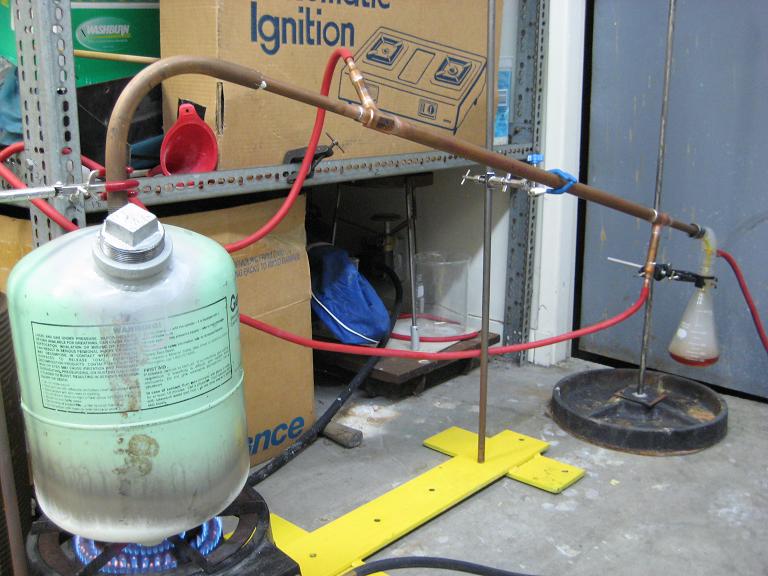
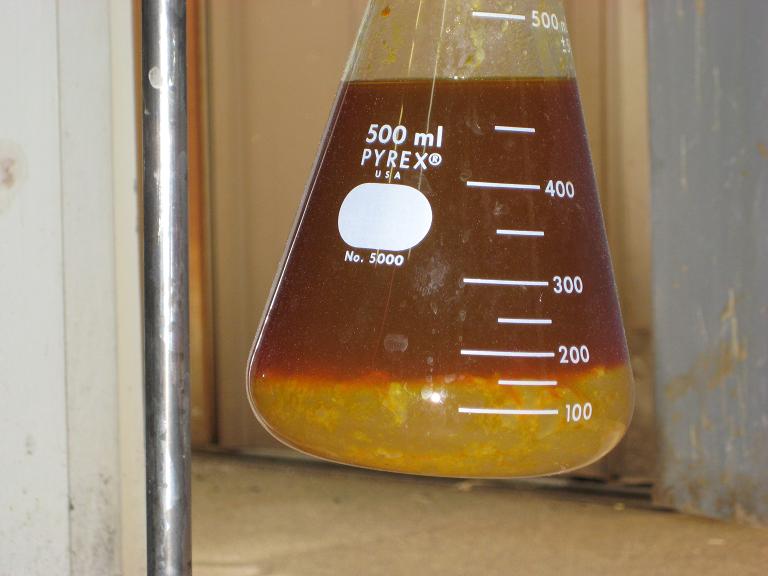
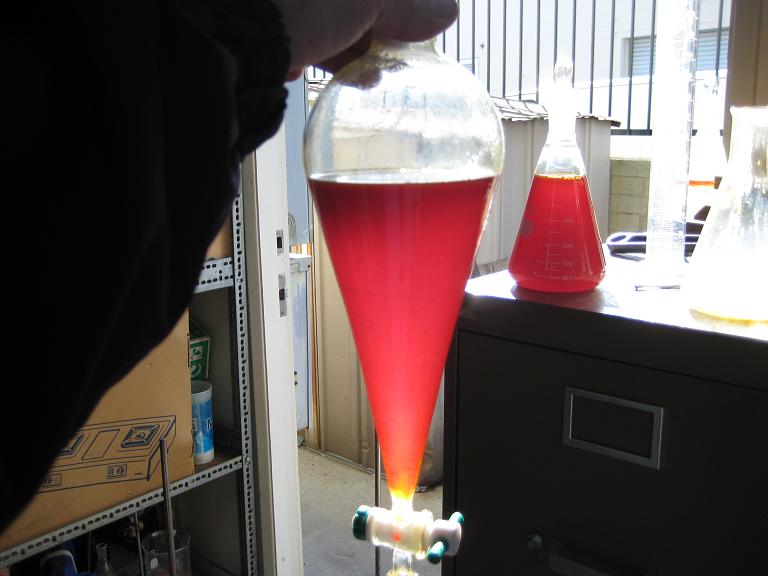
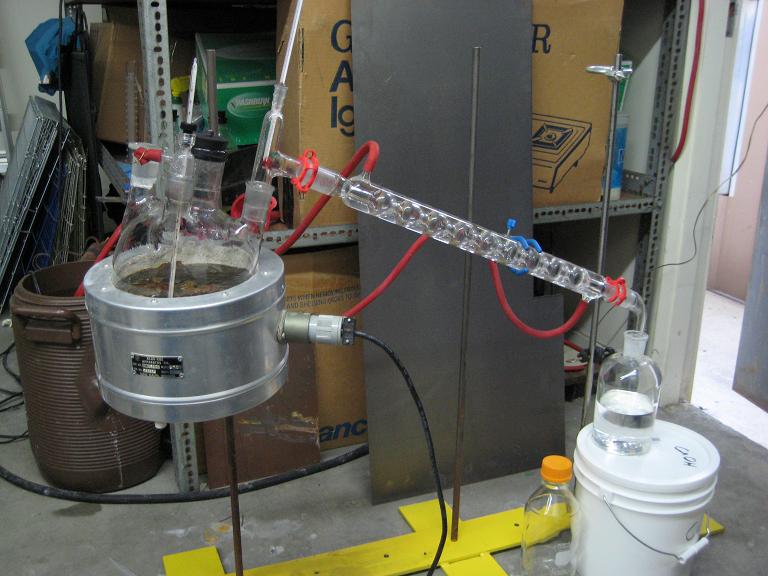
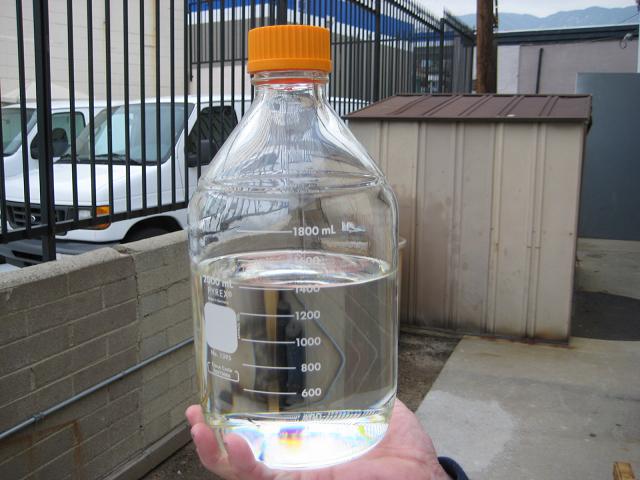
|
|
|
Thor
Harmless

Posts: 19
Registered: 13-6-2011
Member Is Offline
Mood: No Mood
|
|
Today i attempted the synthesis of Benzene from Sodium Benzoate and NaOH.
From 2 runs i obtained approx 28ml of crude product using 60g of Sodium Benzoate and an excess of NaOH. My product contains a layer of water - my
reactants must have been fairly damp. The usual orange precipitate of decomposition products was also formed.
The strangest part was the formation of the white smoke, which made me panic, thinking my condensor was not performing. The 'smoke' did not escape the
distillate flask, so must be contained in the product. Has anyone been able to identify this 'smoke'?
My reaction was abnormal in the fact that distillate was collected from 80-130*C, however if the temperature was dropped, the reaction seemed to
stall. Its a shame the reaction produces such small quantities of Benzene, as I require it as a starting material! Distillation to follow.


|
|
|
MeSynth
Hazard to Others
  
Posts: 107
Registered: 29-7-2011
Member Is Offline
Mood: http://www.youtube.com/watch?v=5ZltqlVuDIo
|
|
Quote: Originally posted by white rabbit  | | I have confirmed the good work others have done. I did not use anything in the retort for thermal conduction, I simply limited the load to around
1000g per run. |
You should have included more information white rabbit.
|
|
|
redox
Hazard to Others
  
Posts: 268
Registered: 22-2-2011
Location: The Land of Milk and Honey
Member Is Offline
Mood: Chalcogenetic
|
|
White Rabbit, a.k.a. ytmachx has a video about this on youtube.
The link: http://www.youtube.com/watch?v=sYyw_hrXrZ8
My quite small but growing Youtube Channel: http://www.youtube.com/user/RealChemLabs
Newest video: Synthesis of Chloroform
The difference between chemists and chemical engineers: Chemists use test tubes, chemical engineers use buckets. |
|
|
MeSynth
Hazard to Others
  
Posts: 107
Registered: 29-7-2011
Member Is Offline
Mood: http://www.youtube.com/watch?v=5ZltqlVuDIo
|
|
He should have posted that link in his post. He should also warn normal people that distilling benzene in doors without proper venting of any possible
fumes is foolish.
|
|
|
testimento
Hazard to Others
  
Posts: 351
Registered: 10-6-2013
Member Is Offline
Mood: No Mood
|
|
Has anyone any source of proof for the following synthesis:
Acetaldehyde + strong base = benzene
p-xylene + aluminium chloride = benzene?
|
|
|
macckone
International Hazard
    
Posts: 2159
Registered: 1-3-2013
Location: Over a mile high
Member Is Offline
Mood: Electrical
|
|
Quote: Originally posted by testimento  | Has anyone any source of proof for the following synthesis:
Acetaldehyde + strong base = benzene
p-xylene + aluminium chloride = benzene? |
xylene + any lewis acid catalyst = benzene + toluene + xylene (mixed) + trimethyl benzenes (mixed)
Numerous sources if you search google.
Entire books have been written on the subject:
http://books.google.com/books/about/Isomerization_and_Dispro...
Toluene disproportionation is a better source because xylene doesn't form as much trimethyl benzenes as toluene forms xylenes. Since methyl groups
don't just disappear the amount of higher order benzene derivatives is proportional to the amount of benzene formed. Of course the reaction can be
forced to benzene by removing the benzene as it is formed.
Of course xylene can be oxidized to acids then treated basically the same as benzoic acid. Which is probably more efficient since xylene is easier to
oxidize than toluene.
As for the acetaldehyde, I would expect there is more to the reaction.
But I haven't researched.
|
|
|